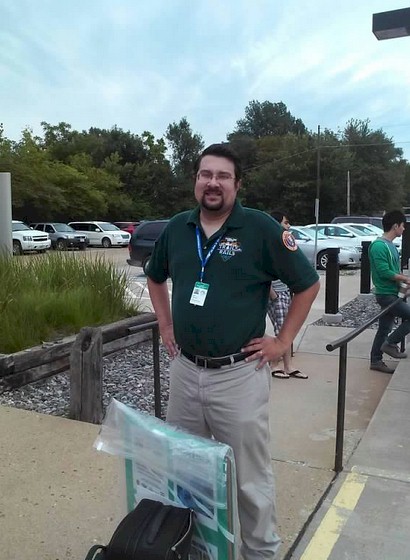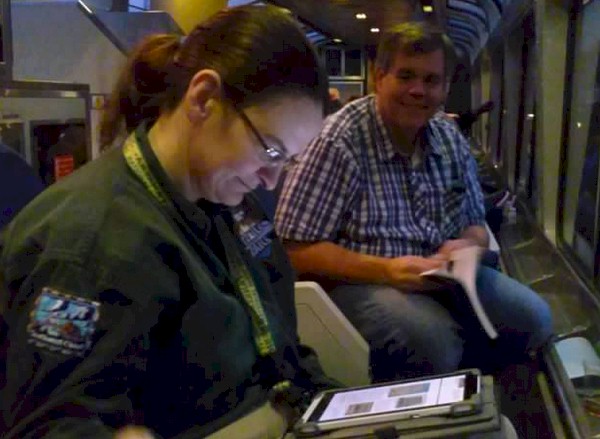
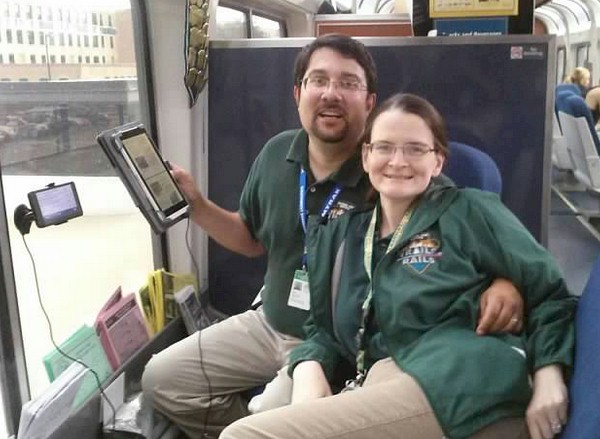
For the past two years now, we have been given the unique task of being the Chicago-based Coordinators of the Trails & Rails program on Amtrak’s Southwest Chief between Union Station and La Plata, Missouri. If you are not familiar with Trails & Rails, it is a partnership program between Amtrak and the National Park Service, which places volunteer guides aboard various Amtrak trains around the country to present interpretive programs in the lounge car. Topics include topography of the region, geology, as well as natural and human history. Earlier this year, I wrote a TrainWeb article about how the Trails & Rails program came into existence at the national level back in the late 1990’s. This article will focus on how our American Passenger Rail Heritage Foundation (APRHF)-sponsored Trails & Rails program got started on the Southwest Chief a few years ago.
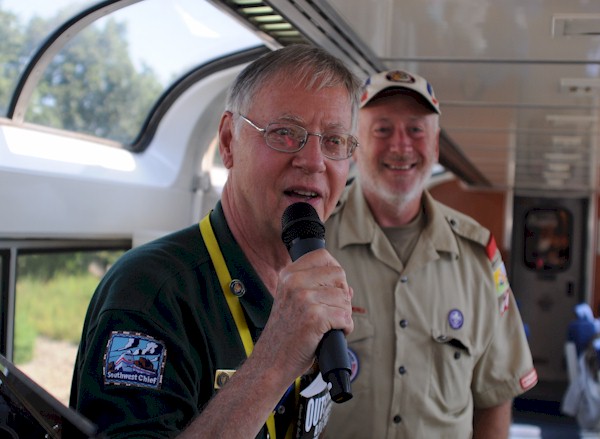 trails2007.jpg
trails2007.jpgMy involvement in the Trails & Rails program began in 2006 when I was traveling on Amtrak's Empire Builder between Seattle and Milwaukee, as part of a trip to Alaska. I noticed there were Trails & Rails guides doing a program in the Sightseer Lounge Car going through Glacier National Park. Since train travel and national parks are two of my greatest interests – I thought it would be a great thing to become involved in someday. I initially thought Trails & Rails was something that only took place on the train through the western national parks, so I was surprised the next day to see guides getting on in the Twin Cities and doing a program all the way into Chicago. The guides mentioned they were part of a relatively new Chicago-based group that presented programs through Illinois, Wisconsin, and Minnesota. I contacted the then-Chicago Coordinator, Jim Carr, who mentioned he was looking for additional volunteers for the 2007 season, since the goal was to have guides do programs seven days per week that following summer. Between 2007 and 2010, I was a guide who presented numerous Trails & Rails programs on the Empire Builde, telling passengers about Milwaukee, the Wisconsin Dells, the Mississippi River, and other topics. I had a good time and got to learn the ropes from some long-time volunteers who had been with the program for the better part of a decade, including on the original Trails & Rails route out of Chicago (to St. Louis on the Texas Eagle between 2000 and 2004).
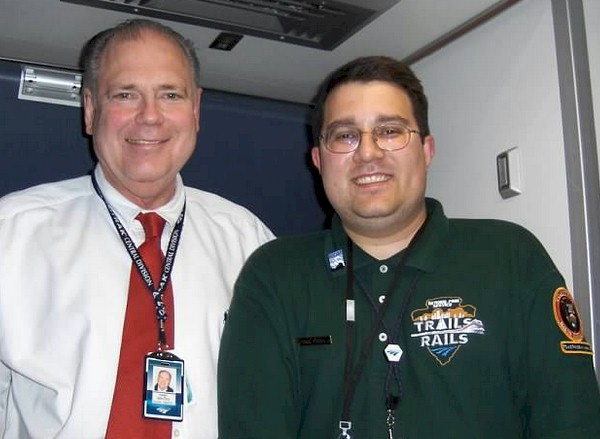
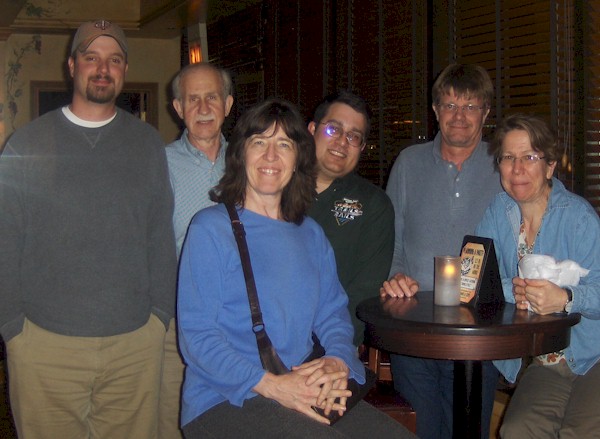
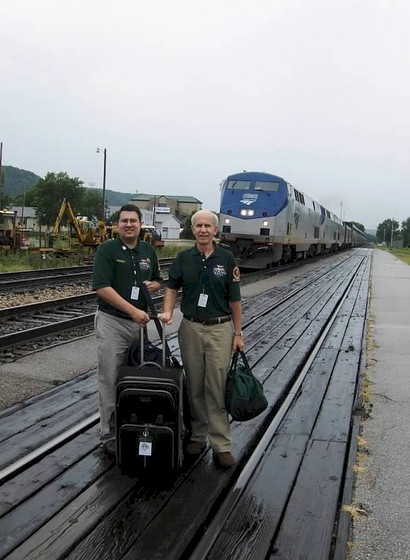
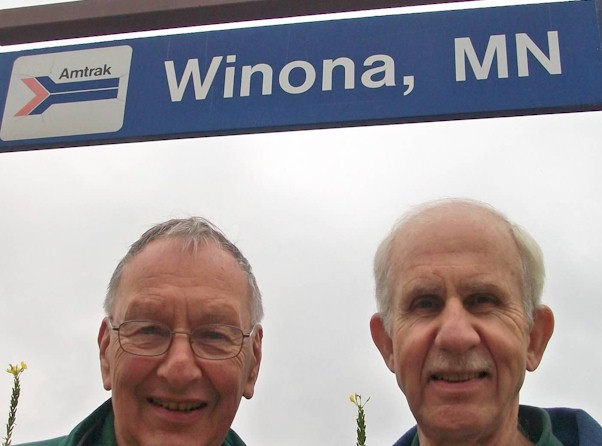
The recession and federal budget cuts that hit a few years ago caused many units of the National Park Service to re-evaluate their interpretive programs. Our then-sponsor park, the Mississippi River National River & Recreation Area in St. Paul, announced in 2010 that our Chicago-based Trails & Rails group would not return for the 2011 season. From what little information we were given by their then-Park Superintendent, the main issue was administrative costs and the expense of the hotel rooms that were provided to our volunteers in Minnesota. Our Chicago-based group, made up of over 50 volunteers, had been presenting a Trails & Rails program on the westbound Empire Builder (Train #7), staying overnight at a hotel in either Winona, Minnesota or St. Paul, Minnesota, and then doing a program the following day on the eastbound Empire Builder (Train #8) into Chicago. Each round-trip had consisted of traveling more than 600 miles through three states. Instead, for 2011 and beyond, our former sponsor park decided to form a new St. Paul-based Trails & Rails group of volunteers that would do a single-day turn program between St. Paul and Columbus, Wisconsin on Train #8 and return home that night on Train #7; thus, eliminating the hotel rooms for guides in their budget.
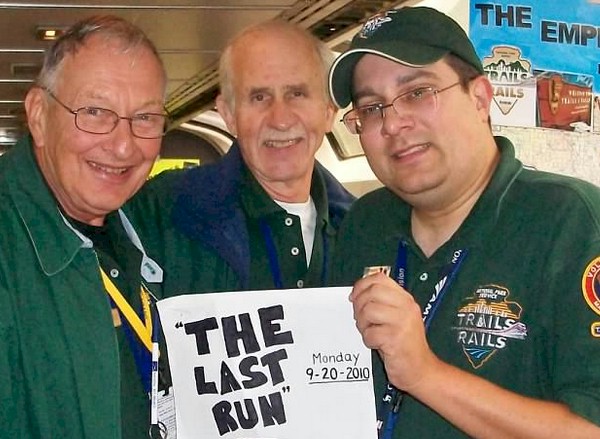
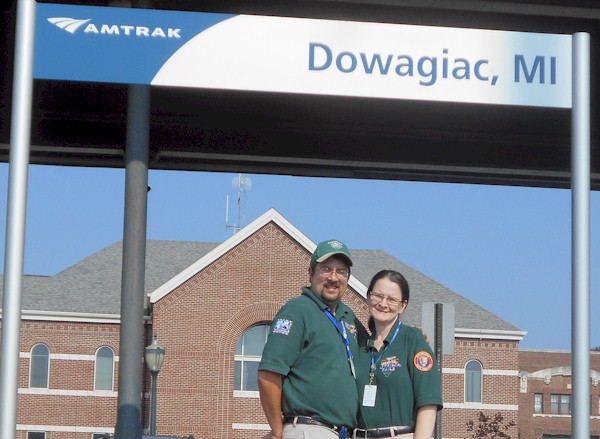
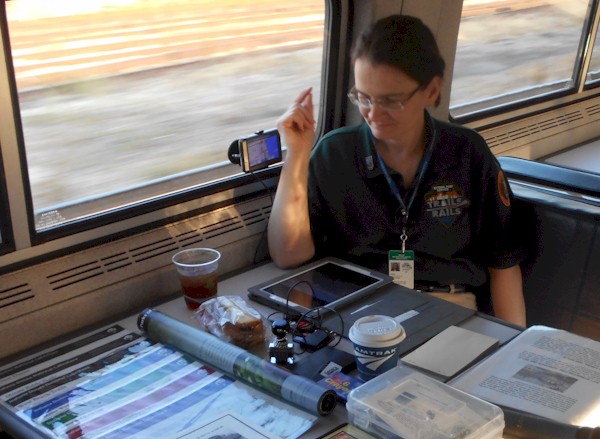
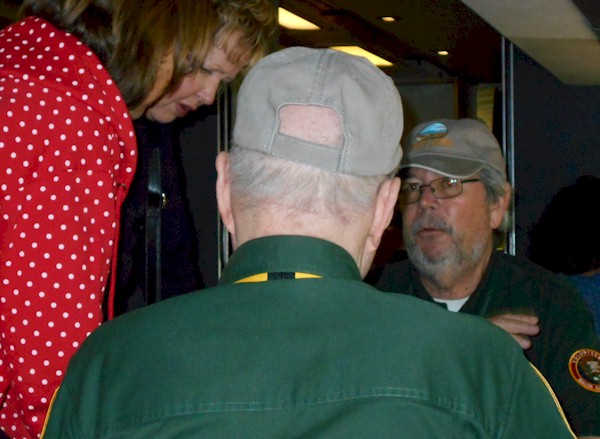
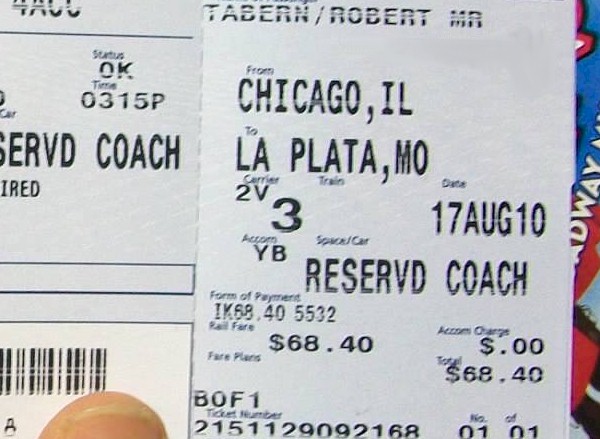
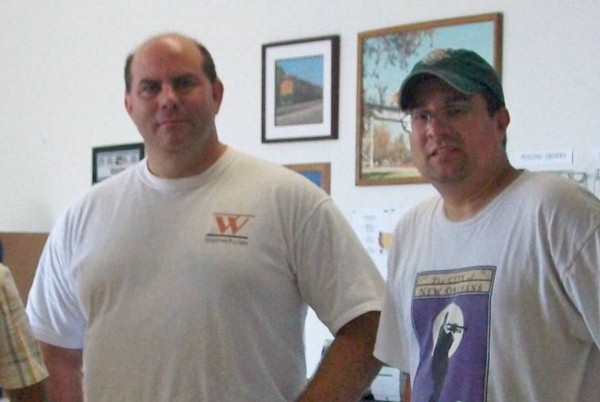
I began making frequent trips out to La Plata starting in early 2011, when Bob and Amy Cox agreed to have three of my railroad photographs on display at the APRHF Silver Rails Gallery. I also met my future wife Kandace that year; and, as we began planning out our wedding for 2012, we decided to hire Bob and Amy Cox to be our wedding photographers. Of course, this meant even more trips out to La Plata in order to work out the details of what would be taking place at our ceremony and reception. With the frequent trips between Chicago and La Plata, we became more interested in some of the sites we saw along the train route of the Southwest Chief. We learned from some of the conductors that during the winter months you can often spot eagles and their nests from the train between Lomax and Dallas City, Illinois along the Mississippi River. Another passenger, who happened to be a history professor at the University of Illinois, pointed out a large hill between Mendota and Princeton, Illinois that was once part of a coal mine disaster in 1909 that killed more than 250 miners; you could also see this from the train. This started to put the idea in our head that the Southwest Chief might be a good candidate to establish a new Trails & Rails program on; there was a lot more stories out there than just the corn and soybeans most people associate with this area. Unfortunately, the way the schedules are written, Chicago-based guides could not go beyond Galesburg, Illinois without needing lodging somewhere; the very issue that had prevented a long-distance Trails & Rails program from operating out of Chicago during the 2011 and 2012 seasons. The thought of guides somehow being able to stay at the Depot Inn & Suites was always in the back of our minds, as this railroad-themed inn in La Plata, Missouri, seemed like the perfect fit.
In an effort to gauge their interest levels, early in 2012, we conducted preliminary talks with all of the parties that would need to be involved in the creation of a Trails & Rails program between Chicago and La Plata, Missouri. When Amtrak, the National Park Service, the APRHF, and the owners of the Depot Inn & Suites seemed to be on board, we brought all the organizations together for formal negotiations. While there have been Trails & Rails guides on the route between La Junta, Colorado and Albuquerque, New Mexico, for many years, there was never been a program on the Southwest Chief through the Midwestern states. APRHF officials saw that sponsoring a Trails & Rails program would be consistant with their non-for-profit mission of helping educate passengers about the landscape and passenger rail opportunities. A deal was struck on December 3, 2012, for one trial season of Trails & Rails to take place on the Southwest Chief from May to September 2013.
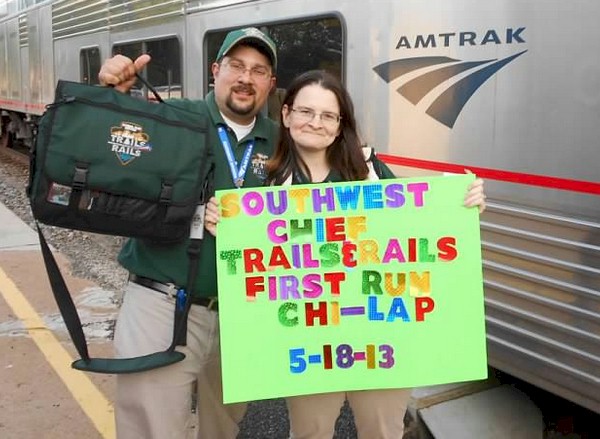
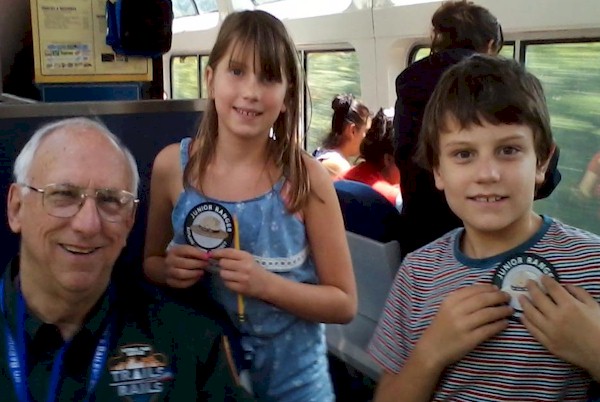

Normally, individual Trails & Rails programs are
managed by a unit of the National Park Service and one of the park’s rangers
serve as the Coordinator. The lack of National Park Service units between
Chicago and La Plata, Missouri, presented a real challenge as to how the group
would be administered. The only National Park Service unit along the train
route from Chicago to La Plata is the Mormon Pioneer National Historic Trail, a
1,300-mile trail through several western states, which commemorates the trek of
the Mormons in 1846 and 1847 between Nauvoo, Illinois and Salt Lake City, Utah.
However, the closest National Park Service rangers who work for the Mormon
Trail are located at an office and visitor center several hundred miles away
from any point of the route of the Southwest
Chief,
making their oversight very difficult. It was decided that the
founder of Trails & Rails/National Coordinator, James E. Miculka,
would be in
charge of the new group; he was generous enough to take on the
responsibilities of managing things from his office at Texas A&M
University in College Station, Texas.
Since Jim already had oversight duties of Trails & Rails on the
national level, and even other duties at the university itself, he appointed us
to serve as the program’s Chicago Coordinators. We oversee the day-to-day
operations of our program on the eastern end of the route; APRHF President Bob
Cox, serves as the La Plata Coordinator, and oversees operations on the western
end of the 298-mile route. Our group’s connection to Texas A&M University’s
Department of Recreation, Park and Tourism Sciences has allowed us to collaborate
with instructor Susan Scott. Susan was instrumental in the development of the
resource manual and educational training of the guides. She continues to be a consultant to our program.
Our Trails & Rails program was given only about six months to get fully organized, with the agreement being formed on December 3, 2012, and guides set to go out on the first trip on May 18, 2013. The first thing we did as Coordinators was put out an advertisement for Trails & Rails guides. Finding qualified guides can be a real challenge for some programs, especially those who are based in smaller towns across the country. Luckily, in such a large city as Chicago, we were able to have a large pool of applicants to choose from. Over the course of two weeks, we ended up interviewing more than 60 applicants at Chicago Union Station, then picking the 25 who we thought were most qualified to participate in the first season. From there, we spent four weekends in a row driving the entire train route between Chicago and La Plata, stopping off in small towns and historical societies along the way to get material and stories for the reference manual we would have to put together. While driving the route in the Chicago suburbs and eastern Illinois can be easy because of many paved roads that parallel the tracks, it can be quite the challenge in southeast Iowa and northeast Missouri, where most highways are gravel or dirt and don’t go along the tracks for long distances. We hope to write a separate Train Web article sometime in 2015 about some of the adventures we had during the drives to produce our Trails & Rails reference manual. So, stay tuned!
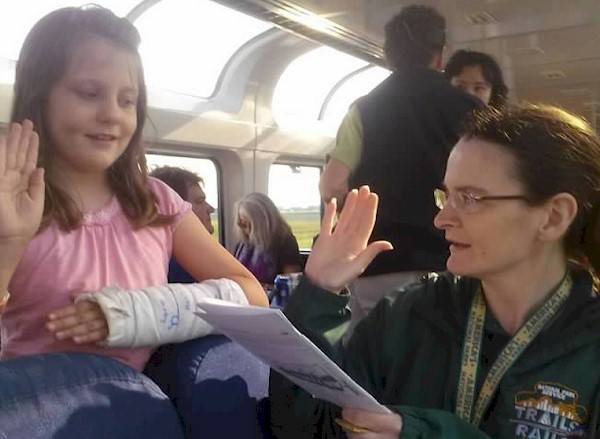
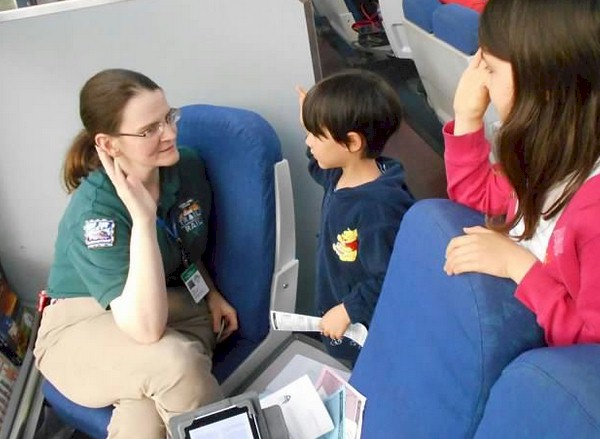
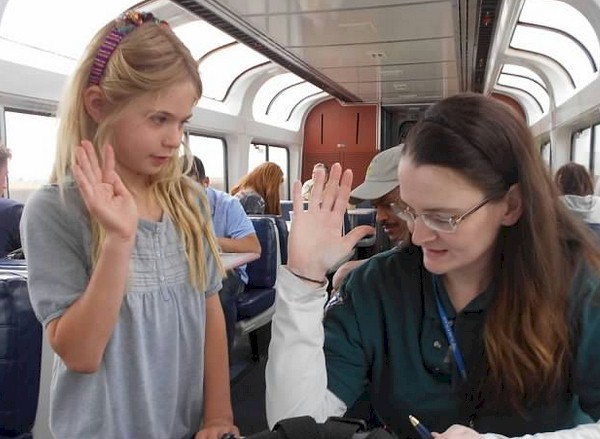
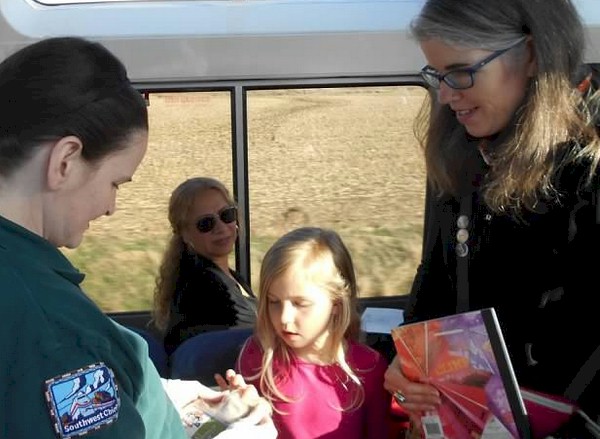
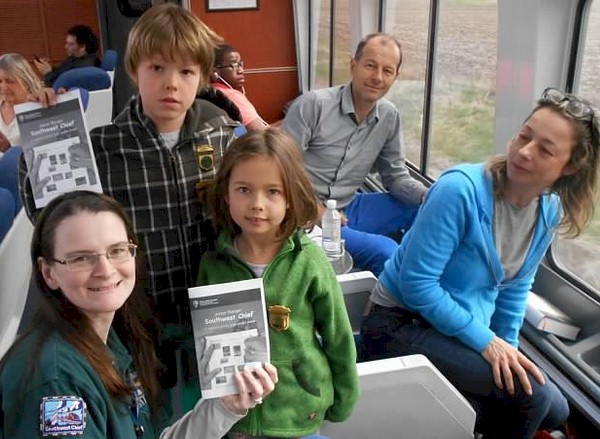
In the end, everything came off without any problems, and our first trip left Chicago on-time at 3:00p.m. on Tuesday, May 18, 2013. We were greeted in La Plata by the local television station and newspaper, who did reports on our new Trails & Rails program. Over the past two years, our volunteers have reached out to more than 40,000 passengers on the Southwest Chief. We would like to thank the National Park Service, Amtrak, APRHF, and the owners of the Depot Inn & Suites for their continued support. We would also like to thank our volunteers who have donated over $3,000 of their own money to purchase a wireless speaker system and various handouts for passengers. If you are interested in becoming part of Trails & Rails on the Southwest Chief in 2015, contact Chicago Coordinator Robert Tabern by e-mailing him at rtabern@yahoo.com.
WE ALSO ASK FOR YOUR SUPPORT BY "LIKING" OUR SOUTHWEST CHIEF TRAILS & RAILS FACEBOOK PAGE.
We are currently less than 20 "likes" away from being the most-liked
Trails & Rails page on Facebook!! This way you can follow our
trips and updates on the group. Thanks in advance!
